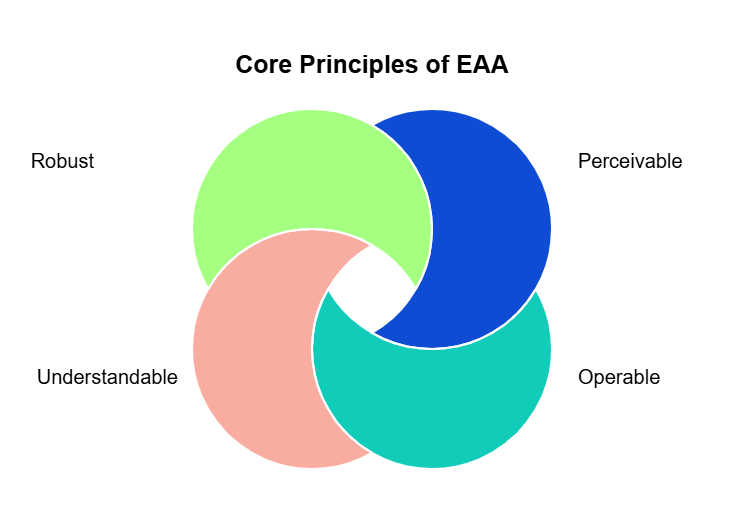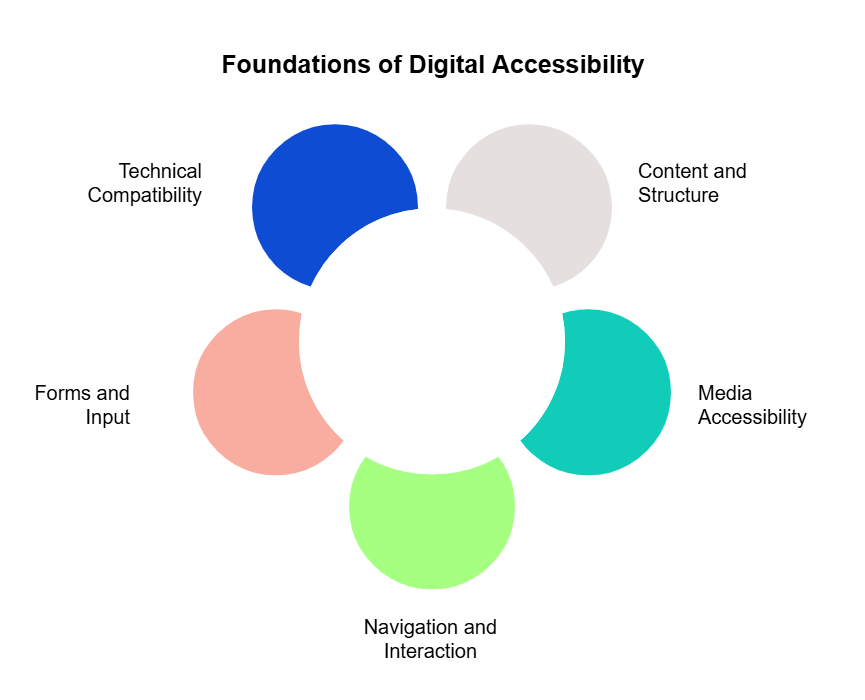Imagine inviting millions of customers to your website and then locking the front door when they arrive on the doorstep.
When you don’t meet web accessibility standards, that's exactly what you're doing.
It used to be the case that you could choose how seriously you took digital accessibility, but that’s no longer the case: The European Union has made the decision for you, so you must comply with tightening legal requirements.
That’s a good thing because it guarantees that your website is welcoming everyone, and because site visitors of all stripes (B2C and B2B) expect bump-free digital experiences.
So, when you comply, there are two major benefits: You avoid penalties and lawsuits, and you demonstrate to your audience that you care about them.
Web accessibility legislation takes effect soon for anyone who serves customers in the EU, so it’s important to understand the law and what it means for your organization.
The EU sets the new accessibility standard
The European Accessibility Act (EAA) is a wide-reaching law that aims to make sure people with disabilities can access digital products and services across the EU.
If you’re already familiar with the EU Web Accessibility Directive (WAD) from the European Commission, the EAA builds on that foundation.
While the WAD focused mainly on public sector websites and apps, the EAA expands those accessibility requirements to many private companies, especially those offering services to the general public.
What’s covered? Just about everything. The EAA applies to digital services like websites and apps, as well as physical products like ticket and banking machines.
For marketers, the key takeaway is that your website, mobile app, online store, digital documents, and even customer support chatbots need to meet accessibility standards.
If you’re offering something to the public in the EU, chances are the EAA applies to you.
Fortunately, the law doesn’t just tell you to “make it accessible.” It points to Web Content Accessibility Guidelines 2.1 Level AA as the standard to follow, which gives you a clear framework for compliance.
Keep in mind that this isn’t just about legal boxes to check. It’s about making your digital presence usable for everyone, which includes millions of people who are often left out.
WCAG 2.1 Level AA explained
WCAG are international standards developed by the World Wide Web Consortium (W3C). WCAG 2.1 Level AA is currently considered the benchmark standard for digital accessibility.
For EAA compliance, your digital content needs to be:
Perceivable: Can people see or hear the content in a way that works for them? (Examples: Alt text for images, captions for videos, and contrast between text and background colors.)
Operable: Can they navigate it using a keyboard, screen reader, or other assistive tools? (Examples: Full keyboard navigation, no flashing content, and easy-to-use forms.)
Understandable: Is the content clear and the interface predictable? (Examples: Straightforward language, predictable navigation, and clear form labels.)
Robust: Does it work well across different devices, browsers, and assistive technologies? (Examples: Compatibility with screen readers, compliant HTML, and future-proof content.)

Why Level AA matters
WCAG 2.1 Level AA is the level most businesses and governments require because it significantly improves access without being overly restrictive or difficult to achieve.
Beyond compliance with the EAA, Level AA reduces legal risks and potential financial penalties, improves your site's overall usability (benefiting all users), and boosts your SEO.
The other WCAG 2.1 conformance levels
There are a total of three conformance levels for WCAG 2.1.
Level A (the lowest level) is the foundation level of accessibility. Think of it as the absolute minimum you should meet, keeping in mind that meeting it offers you no legal protection.
This level includes critical fixes like providing alternative text for images, making sure your site can be navigated by keyboard alone, and avoiding flashing content that can trigger seizures.
While important, Level A alone doesn't fully address many common barriers.
Level AAA (the top level) goes beyond the basics to offer the highest standard of accessibility.
This includes advanced improvements like even stricter contrast requirements, extended audio descriptions for video content, and simpler, clearer language guidelines.
Level AAA is typically seen as aspirational. It can be challenging to fully achieve without limiting content and design flexibility, so most organizations focus on Level AA, the middle ground.
Key dates and deadlines to know
The deadline for affected businesses to have their digital products and services accessible according to the rules was June 28, 2025.
Technically, the EAA became law in 2019. Each EU member state had until 2022 to integrate it into their national laws. You’ve had several years to prepare for this. If you haven’t started making changes, now’s the time.
You could face legal consequences if you don't catch up. More importantly, you’ll risk alienating users who rely on accessible content. Non-compliance could mean fines, lawsuits, or losing business to brands that made the effort.
The good news is Siteimprove can get you where you need to be quickly.
Accessibility in practice
Understanding WCAG standards is one thing, but what does compliance look like in real life?
Here’s a quick, practical breakdown of the changes your team may need to make. This list is not exhaustive, but it will give you an idea of how you can make big improvements to your digital experiences.

1. Content and structure updates
Clear headings and subheadings: Make sure your content has logical structure with proper heading tags (H1, H2, H3, etc.) so screen readers can follow along. It should also use proper semantic HTML so assistive devices understand page structure.
Descriptive link text: Replace vague phrases like “click here” with clear, descriptive labels so everyone knows exactly where a link will take them.
Readable text: Check contrast ratios and font sizes so text is easy to read for people with vision impairments or older users.
2. Media accessibility
Alternative text (alt text): Include descriptive text for images, graphics, and other visual elements. This helps visually impaired users understand your content through screen readers.
Captions and transcripts: Videos and audio content need captions or transcripts to assist people with hearing impairments.
Audio descriptions: Provide audio descriptions for video content that includes important visual information not conveyed through audio alone. This helps people who rely on audio cues to fully understand your multimedia content.
3. Navigation and interaction
Keyboard-friendly navigation: Users should be able to move through your entire site using just the keyboard. Make sure all buttons, links, and interactive elements are accessible without a mouse.
Predictable user interface: Navigation menus, buttons, and forms should behave consistently, without surprises. Most importantly, anything clickable should work properly.
Skip links: Include "skip to content" links at the top of pages so keyboard users or screen reader users can bypass repetitive navigation elements and jump straight to the main content.
4. Forms and input
Clear form labels: Every field in a form should have descriptive labels so users know exactly what information you’re requesting.
Error messages and instructions: Provide clear guidance when users make mistakes or miss required fields.
Form validation: Clearly notify users if form entries contain errors, and make sure those notifications can be easily understood by users relying on assistive technologies.
5. Technical compatibility
Assistive tech compatibility: Your website and apps need to work smoothly with tools like screen readers, magnifiers, and speech recognition software.
Responsive and adaptable design: Content should adapt automatically and gracefully to different screen sizes, orientations, and devices.
Compatibility testing: Regularly test your website and digital content with the latest assistive technologies and browsers to identify issues. Most importantly, maintain compatibility as technologies evolve.
Who’s responsible for compliance?
Accessibility is bigger than your digital marketing team. It’s a shared responsibility that impacts every team and department in your organization.
That said, marketing teams are often on the front lines. You create the content, design the campaigns, and build the experiences people interact with first. If your emails, landing pages, videos, or PDFs aren’t accessible, that’s a problem. Compliance with the EU accessibility legislation needs to be baked into every brief, every asset, every review.
Web and product teams are responsible for building and maintaining the digital platforms that content lives on. They handle the code, structure, and UX, so collaboration between marketers and developers is key.
This means that accessibility needs to be part of your design and development process. It has to be part of the conversation from day one.
Vendors and procurement also have a part to play. If you're using third-party tools, agencies, or platforms, their output needs to meet accessibility standards too. You’ll need to check that their tools are up to the job before you start working together.
This all means that compliance is a team sport. It works best when everyone — from marketing to IT to procurement — keeps accessibility in mind.
If that sounds like a lot to manage, you’re right. Some organizations appoint an accessibility officer (or even “accessibility czar”) to oversee the inclusiveness of their products, platforms, and experiences.
However, this is an arena where software shines.
Tools like Siteimprove make it easier to manage accessibility across teams, content types, and digital channels. Instead of relying on scattered checklists or manual reviews, Siteimprove scans your website for WCAG issues, prioritizes fixes, and tracks progress over time.
Siteimprove also integrates with your CMS and workflows, so your team can catch and correct accessibility issues before anything goes live. With the right platform in place, you can proactively address accessibility at scale.
The importance of accessibility statements
The EAA doesn’t require accessibility statements, but certain countries within the EU, like Germany, Spain, and Italy, do, and there are variations in terms of what’s expected by each country, with some countries requiring that you follow a particular template. (Yes, it’s messy.)
Since you can’t have a single accessibility statement that will work for all EU countries, your best bet is to create one that is modular and hits on the requirements for countries that you do business in. Ideally, you should get input from local accessibility or legal experts to make sure you’ve got it right for each country.
Siteimprove has an accessibility statement generator that can get you started. All you need to do is input details into fields and the generator will automatically create your statement. Again, you’ll likely need to make adjustments to meet the requirements of each country, but the tool will do the bulk of the work for you.
Beyond legal compliance
Complying with the EAA is important to avoid fines, lawsuits, and regulatory headaches, but there are other advantages that serve your business in the long-term.
Getting accessibility right can protect your brand and boost performance.
Strengthen brand trust with users and stakeholders
When you prioritize accessibility, you show customers (and your internal team) that inclusion matters. That builds trust, improves your reputation, and sets your brand apart.
Admittedly, this is a soft effect that you can’t measure right away, but from experience we can tell you that it offers a compounding effect over time.
Reach new customers
There are over 87 million people in the EU with disabilities, many of whom rely on accessible websites and apps. Making your digital experiences accessible means you’re opening the door to a huge audience that’s often underserved.
Keep in mind that “disability” is a broad category. It includes more people than you might expect. For example, a broken finger can mean that someone as disabled, temporary though it may be.
Reduce friction across your customer journey
It’s no secret that customers prefer to use digital platforms and tools that are easy to use. If you frustrate someone with a complex interface or confusing instructions, they’ll find a new method to meet their needs.
Accessible design often leads to a smoother, cleaner and faster user experience, even for non-disabled people. The benefits are undeniably good for for your business:
- Lower bounce rates
- Longer session durations
- Higher engagement with content
- Better self-service (less support needed)
- Higher conversion potential

As you can see, accessibility is a win for your audience and your marketing metrics.
Boost search engine rankings
Accessibility and SEO go hand in hand. Many of the accessibility improvements you make to your site are also positive SEO signals to Google and other search engines.
Features like image alt text, proper heading structure, and video transcripts not only help users with assistive tech, they also make your site easier for search engines to understand and rank.
More broadly, search engines prioritize sites that are clear, easy to use, and hold people’s attention. Accessibility brings all of that to the table.
Accessibility is not one-and-done
The EAA sets the standard today, but who knows what the future holds.
Accessibility isn’t a box you check and forget. Standards evolve, content changes, and new tools and technologies come into play. Today's accessible products may not meet tomorrow's standard.
That’s why ongoing testing is essential. Regular audits help you catch new issues as they pop up, especially when you're constantly launching new campaigns or updating your site.
The key is to build accessibility into your long-term strategy. Bake it into your workflows, templates, and review processes so it becomes second nature.
Most importantly, keep yourself informed. Accessibility standards like the WCAG continue to evolve alongside user expectations. It's your responsibility to keep up.

Ready to create more accessible and inclusive web content?
Siteimprove Accessibility can help you create an inclusive digital presence for all.
Request a demo
